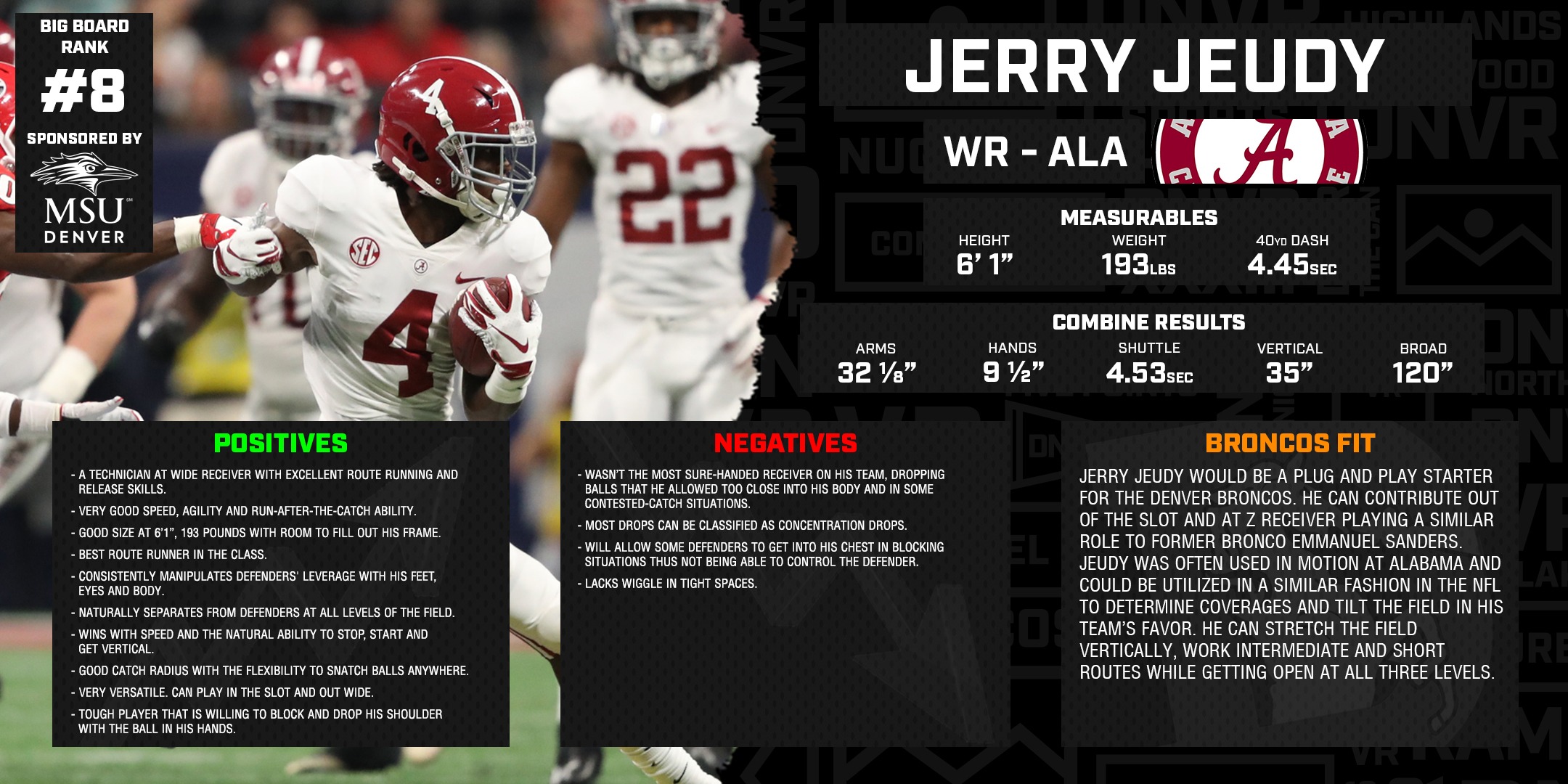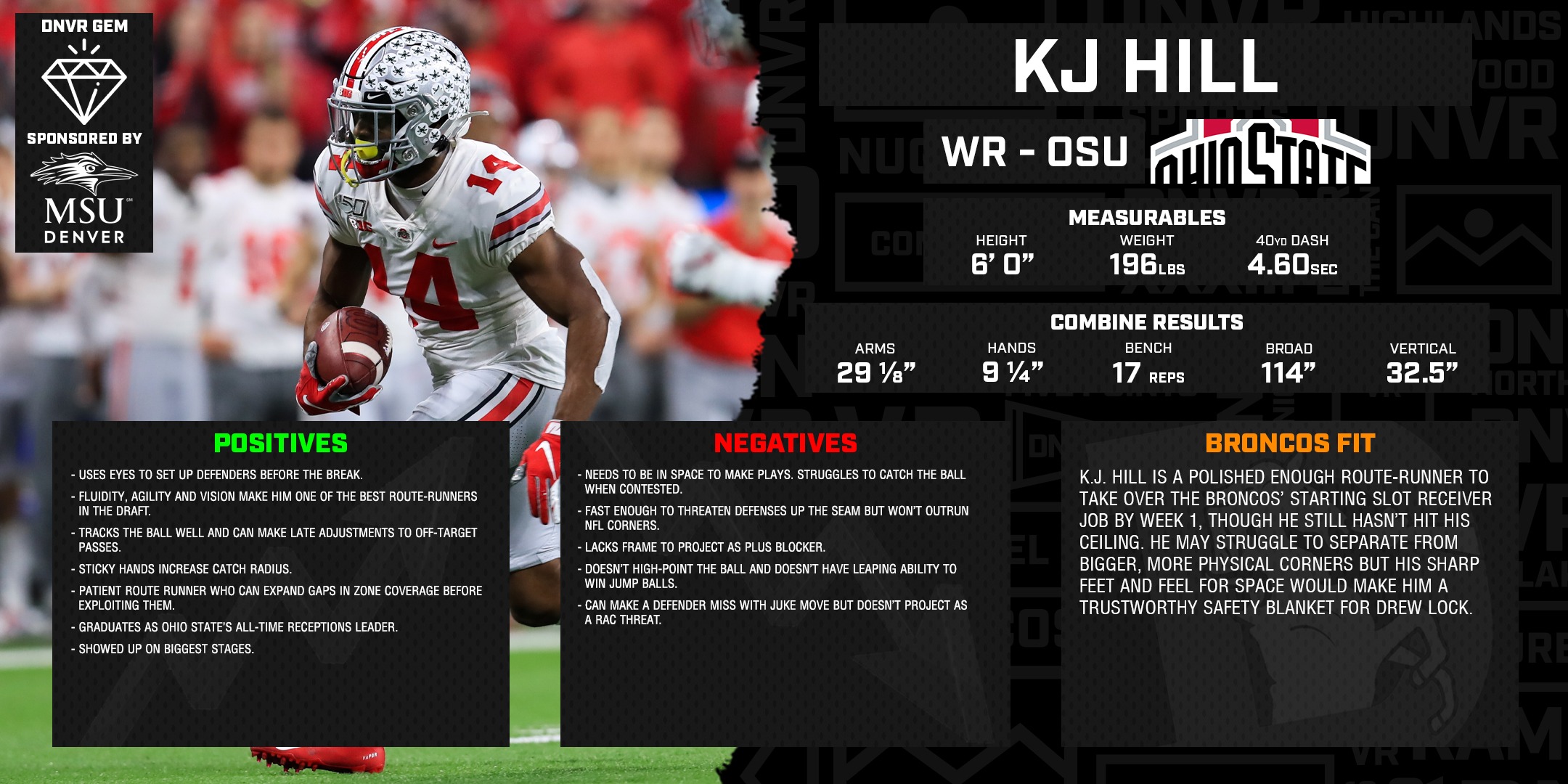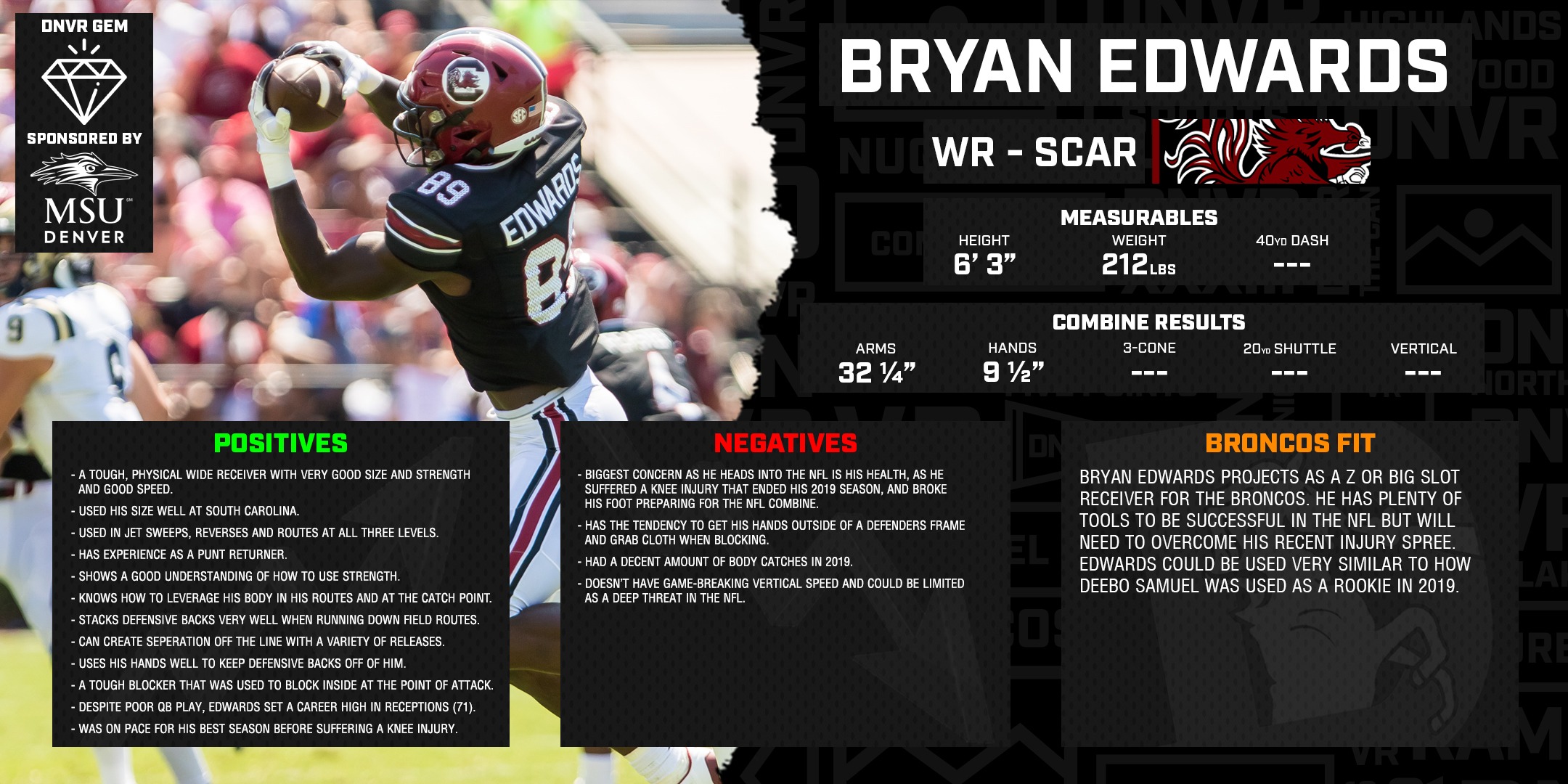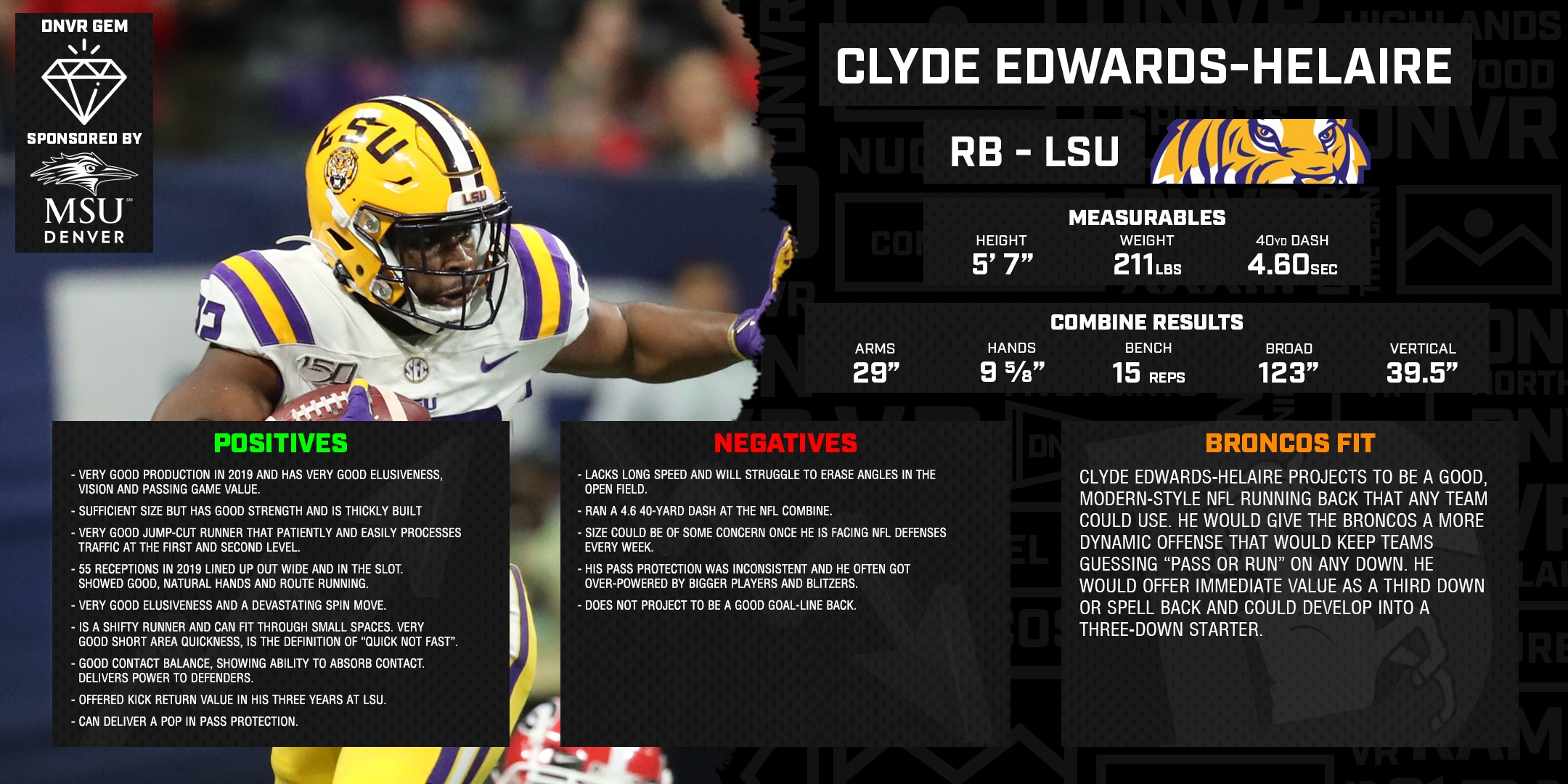© 2025 ALLCITY Network Inc.
All rights reserved.

With the dust settled on the first fully digital and historical 2020 NFL Draft, it’s time to dig deep into all 32 teams’ draft classes, starting with the AFC West and how the division stacks up with the rest of the league.
A quicks note on our grades: these are based on our rankings, and the specific value gained or lost with each selection. Team needs and system fit were taken into consideration as well, as those are important factors in a prospect maximizing their on-field value. Adding top-100 level prospects—all projected-future starters—with picks in the first three rounds, is the baseline with these grades, everything goes up or down from there.
With all that, here’s how the 2020 NFL Draft shook out.
AFC West Grades
Denver Broncos: A
(Six top 100 prospects and three second-round grades or better)
The Broncos identified the strengths of this draft and attacked a need they’ve had at receiver for years. Now, Denver has three new wideouts, all faster than a 4.45 and all complementary to each other. Adding Drew Lock’s favorite college target and a legitimate top-100 prospect in Albert Okwuegbunam was the cherry on top, suddenly making this receiving core scary and very, very fast.
The old adage of building a receiver room like a basketball team rings true in the modern NFL, where spread offenses are in vogue, and three-receiver sets are the norm, and that’s exactly what Denver was able to accomplish. Okwuegbunam and Noah Fant are the centers, Courtland Sutton the star power forward, Jerry Jeudy is a deadly wing who’ll benefit from iso situations and K.J. Hamler is the point guard who brings spacing to the offense with his speed.
Addressing that need was key and the Broncos did it in waves. They obtained great value at the top by selecting a bonafide top-10 talent and then again with the selection of Hamler, who could be an instant playmaker if put in the right hands.
John Elway’s draft haul is really highlighted by those receivers and the great value the Broncos got in the middle-third round by selecting Lloyd Cushenberry III. The LSU captain is coming off a superb season, has true high-end tools for a center, and is a high-character leader for the offense. His selection was a huge win for the Broncos, who came away with three prospects who graded out as second-rounders or better.
With the selection of Iowa cornerback, Michael Ojemudia, Fresno State offensive lineman Netane Muti and the aforementioned Okwuegbunam, the Broncos were able to get three additional quality players who carried third-round grades as projected future starters. That’s quite a haul, especially offensively with five of those players.
The other four picks were more of the boom-or-bust variety, though Denver did mitigate the risk by the high-character individuals they went after. McTelvin Agim fits that label most of all as a supremely athletic but still very raw defensive lineman. Tyrie Cleveland also fits the description, as the former highly-recruited receiver never reached the lofty potential he showed as a freshman at Florida.
The more intriguing day-three selection was Justin Strand, who has appealing traits as a cover linebacker but lacked elite flashes and great closing ability. The other late seventh-rounder, Derek Tuszka, brings more physicality and motor to a young edge-rusher rotation.
Denver was unable to address their left tackle position in a front-loaded and deep class and clearly weren’t interested in some of the shorter-armed prospects who were available later in the draft, opting to address other needs instead.
Riskiest pick
McTelving Agim, Tyrie Cleveland, Netane Muti, or even Albert Okwuegbunam are all a bit boom-or-bust players, but in the end, K.J. Hamler is the riskiest pick the Broncos made in 2020.
Hamler wasn’t a bad value where the Broncos got him, but he is undersized, mostly limited to playing in the slot, and will need the right type of system to maximize his talents. His ACL tear from his freshman year at Penn State also presents some risk, though he’s been stellar ever since returning to the field. The upside for the 20-year old is impressive, but it does come with some real risk as well.
Best pick
Cushenberry was a great value, but the best pick is undoubtedly Jerry Jeudy at 15 overall. Jeudy has been a star with NFL-ready skills for a few years now, for him to have dropped to Denver despite having a fairly flawless draft process is baffling, a true run of good fortune for the Broncos who now have a legitimate star receiver opposite Sutton.

Kansas City Chiefs: B-
(One top-40 prospect, three in the top 100)
The question with the Chiefs, who soon will have to pay Patrick Mahomes, is if they really were able to plug key future holes or if instead, they opted for too many gambles on upside. Of course, from a rival perspective, those gambles for a team as loaded as KC already is are scary, but with only one player in our top 40 and three in our top 100, the Cheifs had a good but far from extraordinary class.
In the Chiefs’ offensive system, first-round running back Clyde Edwards-Helaire has a great opportunity to exceed his ranking as a perfect fit in KC’s backfield. Getting third-rounder Lucas Niang, if healthy, could be an even better value as they could’ve found a $10-million starter in the towering right tackle.
The argument is that they could’ve waited on a running back and got even better value in round one, especially in the trenches when talent remained at the end of the first.
The bigger risk pick was the selection of Willie Gay Jr. in the second round, who didn’t see the field much at Mississippi State and felt like a slight reach in the top-two rounds.
Their third-day was uneventful with just three picks. Combine warrior L’Jarius Sneed was the most interesting selection, as a raw, toolsy piece to their secondary with some versatility.
Riskiest pick
Willie Gay Jr. didn’t play much at Mississippi State for a variety of different off-field incidents that limited his playing time. The primary issues were related to him getting ejected in two games and suspended for another eight in an academic scandal, both relatively minor issues as far as off-field red flags go. However, there’s a lot of projection with the workout warrior who’s only shown flashes at this point in his career.
The Chiefs are gambling that they can give him some continuity and develop Gay Jr. enough to let him be the heat-seeking missile that he is. He brings a different dimension than any linebacker on their roster, so the upside for the 83rd prospect on our board is there, but so is the risk.
Best pick
Niang is the best value pick at a premium position, but the best pick here is Edwards Helaire, who landed in the perfect situation under Andy Reid and Eric Bieniemy. His receiving skills in this offense give CEH the chance to be a dynamic weapon early on who could really benefit from the spacing the Chiefs’ other weapons would give him.
Based on their evaluations at this stage of their careers, the Chiefs’ first-rounder is better than Kareem Hunt was coming out of Toledo, a scary proposition as offenses all over the AFC West got significant upgrades in talent.
Los Angeles Chargers: B-
(three top-100 prospects but two first-round grades)
In the last few years, my rankings and the Chargers’ selections have consistently lined up; the only commonality I can find is that they are good about taking the best player available on the board and not forcing too many needs. This year, that could’ve hurt them, as the selection of Justin Herbert as the sixth-overall prospect is certainly understandable but not great value.
What really stood out about the Chargers approach was that they aggressively moved back up into round one to get a key upgrade at middle linebacker in Kenneth Murray. That selection came at a high cost—both the Bolts’ day two selections—which left them out of the offensive tackle market, leaving them to start an unknown young player if they can’t pick up a veteran on the right side.
Their grade did get a bump with the selection of slot receiver K.J. Hill, who compliments the bigger wideouts the already had. The Chargers followed the adage of building their receiver room like a basketball team by adding Hill and speedster Joe Reed, who’ll impact the return game and be a weapon in the screen game.
Safety Alohi Gilman was a fair value on day three, as a day-three gem in our rankings. He’ll be a reliable backup who could be thrown into the fire and be respectable on a veteran defense. The real intrigue from the day-three picks is at running back where UCLA’s Joshua Kelly, could be a perfect complement to Austin Ekeler as the No. 2 back in LA.
Ultimately, this draft will come down to Herbert’s development and how costly passing on a top tackle ends up being. The Chargers got appropriate value with all their picks but took on some risk and didn’t have any massive steals until late on day three.
Riskiest pick
Justin Herbert is the riskiest pick, and it’s not even close. Herbert looked like a lock to be the first quarterback taken in the 2019 draft due to his play midway through the 2018 season before his play fell off a cliff, prompting him to stay in school. His on-field production and efficiency improved in 2019, but he still lacked big moments in an offense that asked him to be a game manager rather than their catalyst.
He’ll have a lot of weapons in LA with a veteran offensive staff, if the O-line can hold up, Herbert finds himself in a pretty good situation. His natural talent is undeniable, but a lot of his career may be determined by the type of confidence and rhythm he’s able to get in early in his career with an offense that’s tailored to his skills.
Best pick
As mentioned above, the K.J. Hill pick really tied this draft class together, giving the Chargers a weapon in the slot who can get open within the first five yards. That type of wideout was missing in LA, where Keenan Allen and Mike Williams need a bit more time to get open. With those two on the outside and Hunter Henry back, Hill should be freed up to work over the middle and be a nice outlet for whoever the Chargers starting QB ends up being.

Las Vegas Raiders: C
(Four top-100 prospects, every selection carried a draftable grade)
This is two consecutive underwhelming drafts under Raiders general manager Mike Mayock, as the haul with two first-rounders and five picks in the first three rounds didn’t exceed expectations.
Adding the fastest offensive playmaker in the draft in Henry Ruggs III was interesting, as the Raiders’ vertical passing game has been non-existent under Jon Gruden. Ruggs’ mere presence on the field should open up room for the dink-and-dunk passing game underneath, but the real question is if the first wideout taken in the loaded 2020 draft will ever be more than a glorified decoy.
The worst pick of the division was Vegas’ second first-rounder, where they selected Ohio State’s No. 2 corner in Damon Arnette. Arnette’s selection is defensible; after all, he is a good player who projected as a future NFL starter at a premium position, but in the top-20, he’s a reach.
After that, the playmakers the Silver and Black added on offense with speedy playmaker Lynn Bowden Jr. and underrated gem Bryan Edwards are nice pickups, as is safety-linebacker Tanner Muse. While the picks were good, outside of Edwards, the value here was about right.
Undersized cornerback Amik Robertson will be in the running for the Raiders nickel spot and is a feisty cover corner, while guard John Simpson adds depth and physicality to the line.
The Raiders added more young pieces, but it’s hard to feel like they adequately patched up the question marks that remain on defense and at quarterback. All those extra picks were obtained by trading away true franchise cornerstones like Khalil Mack and Amari Cooper, from our vantage point Vegas hasn’t recouped an adequate return for those losses.
Riskiest pick
This is easily Arnette, as the Raiders amazingly went back to select the No. 2 cornerback out of Ohio State despite the disastrous selection of Gareon Conely just a few drafts ago.
Arnette is fluid in coverage with good ball skills and had some late first-round buzz before running an underwhelming 4.56. In a deep cornerback class that was a bit light at the top, he was a true reach at 20 and probably an overreaction to the Atlanta Falcons reaching themselves on cornerback A.J. Terrell from Clemson.
With a bunch of talented receivers being added in the division, an average athlete with average size like Arnette has his work cut out.
Best pick
Don’t be surprised if Bryan Edwards ends up being the Raiders’ best receiver by the time rookie contracts are up for this class. His movement skills after the catch at his size are impressive, and he would’ve probably gone higher had he been able to test at the combine or simply been in a more shallow receiver class.

The best (and worst) of the rest
Best
Dallas Cowboys: A++
(FOUR second-round grades or better, five top 100)
The best class of the 2020 crop. The Cowboys got second-round value with four of their picks and added five top-100 prospects. Picking in the middle of each round with just three picks in the top-three rounds, Dallas came away with a major injection of talent.
Cincinnati Bengals: A
(six top 100! three second-round grades)
Having the first pick of each round is huge, and the Bengals capitalized regularly, adding a franchise quarterback, stud receiver, and two potential immediate starters at linebacker. They got excellent value on day three as well in a class that compared pretty favorably to the Broncos’ haul.
Minnesota Vikings: A
(six top-100 prospects, three top-three tiers)
The Vikings top-three picks alone are all immediate contributors who ranked in our top 30. With an absurd 12 more picks after that, they came away with three more future starters in what should be a foundational draft for them.
Worst
Seattle Seahawks: F
(on top-100 prospect)
The Seahawks always operate independently of the consensus in the draft, which I respect tremendously, but the lack of value with their early picks was shocking. Seattle regularly bypassed more talented, well-rounded prospects for limited players with obvious deficiencies.
New England Patriots: D
(one top-50 prospect, three in the top 100)
The Patriots loaded up on edge rushers and tight ends early and then got a bit too fancy with a kicker early on day three, before loading up on offensive lineman. For a team in a rebuild, they seemed to plug too many minor needs rather than focusing on adding potential foundational pieces.
Green Bay Packers: D-
(one top-50 prospect)
The Packers best pick was quarterback Jordan Love, who they moved up to select. It’s what they did later that was baffling, especially on day two, where they squandered the value of their picks by adding essentially specialty players for their Shanahan-style offense. In a closing window, they chose to add for unproven head coach Matt Lafleur instead of for Aaron Rodgers’ final run.
Everyone else
Arizona Cardinals: A (two round-one grades, four in top 100)
Atlanta Falcons: C- (three top-100 prospects, only one top 50)
Baltimore Ravens: A (five top-100 prospects, three with a second-round grade or better)
Buffalo Bills: C+ (two top-100 prospects, one first-round grade)
Carolina Panthers: B+ (four top-100 prospects, three second-round grades or better)
Chicago Bears: C (two top-100 prospects, one second-round grade)
Cleveland Browns: B- (two top-100 prospects but two in top-two tiers)
Detroit Lions: A (five top-100 prospects, two first-round grades)
Houston Texans: B (two top-100 prospects, one in the top 30)
Indianapolis Colts: B- (two top-50 prospects, three in the top 100)
Jacksonville Jaguars: C+ (zero round-one grades, three top-50 prospects, five top 100)
Los Angeles Rams: C+ (four top-100 prospects)
Miami Dolphins: C- (three top-three tier picks, five top 100)
New Orleans Saints: B- (two top-50 prospects)
New York Giants: B- (four top-100 prospects)
New York Jets: B+ (four top-100 prospects, two round-one grades)
Philadelphia Eagles: B+ (four top-100 prospects, two top 50)
Pittsburgh Steelers: C+ (one top-50 prospect, two top 100)
San Francisco 49ers: C (one round-one grade, two top 50)
Tampa Bay Buccaneers: B- (two top-three tier prospects, two top 100)
Tennessee Titans: D (two top-100 prospects, one top 50)
Washington Redskins: B+ (four top-100 prospects)
Comments
Share your thoughts
Join the conversation




